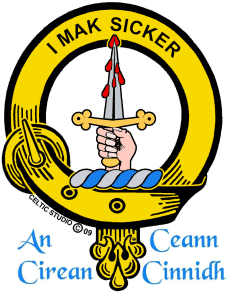 KIRKPATRICK
KIRKPATRICK
 |
| The name of Kirkpatrick is common in Dumfries-shire, where it is derived from a chapel in the Church of the Convent of the Minorite Friars (Greyfriars Church) dedicated to St Patrick in the parish of Closeburn.
The name is thus literally derived from this place, the church of Patrick, to forever commemorate the bloody deed that took place in that church in 1306. Whether fact or legend it is what adds colour to Scottish history that
fascinates people around the world. |
| According to tradition, the family of Kirkpatrick of Closeburn has held lands in this dale since the ninth century. They first appear in records
in the twelfth century, when Ivone de Kirkpatrick witnessed a charter of the Bruce family. Alexander II granted a charter of confirmation to Ivone of his lands. |
| Roger Kirkpatrick was one of the attendants of Robert the Bruce at Dumfries when he met and slew the Red Comyn. Kirkpatrick is
said to have met The Bruce rushing out of the church exclaiming that be believed he had killed Comyn. Kirkpatrick drew his dagger with the words, "I'll mak siccar" or "I mak sicker" meaning "I'll make sure" and went into
Patrick's church and finished the task! This became the Clan motto and is surprisingly one of the few Scottish Clan mottos that is in Scots dialect. The Clan crest is described in heraldic terminology as "A hand holding a dagger in pale distilling drops of blood, Proper. Rogers bold and gruesome act is therefore commemorated forever in the annuals of Scottish history for all to know. |
 |
In 1314 he was sent
as an emissary with Sir Neil Campbell to England and in recompense the family received the lands of Redburgh. In 1355 Sir Roger Kirkpatrick distinguished himself by taking Caerlaverock and Dalswinton Castles from
the English, thus preserving Nithsdale. His kinsman, Sir James Lindsay, in a private quarrel in 1357, murdered him. The title passed through a nephew to Sir Thomas Kirkpatrick, who had a charter of resignation to the baronies of
Closeburn and Redburgh from Robert, Duke of Albany, in 1409. His grandson, another Sir Thomas, was taken prisoner at the Battle of Solway Moss in 1542. The estate again passed through a cousin and in 1685 Sir Thomas Kirkpatrick of
Closeburn, for his fidelity to the cause of Charles I, was created a Baronet of Nova Scotia. |
| The mansion house built by the first Baronet was later destroyed by fire. Sir James, the fourth Baronet, sold the estate of Closeburn. William Kirkpatrick, a descendent of the Kirkpatrick of Conheath, was a wine merchant in Malaga in Spain, who married the eldest daughter of a Belgian baron. His great-granddaughter, Eugenie, became the last Empress of France when she married Napoleon III. |
| The names Kirkpatrick and Kilpatrick have long been associated with the Clan Colquhoun although there is also a strong connection with the Clan
Douglas. There is no current Clan Chief of the Kirkpatricks or a Clan tartan. They are considered, by Lord Lyon as a lowland armigerous Scottish Clan. There are several variations of the Kirkpatrick name; Kilpatric, Kilpatrick, and Gilpatrick. |
Written and researched by Louis James Walsh.
http://www.celticstudio.com |
| e-mail: orders@celticstudio.com | |

